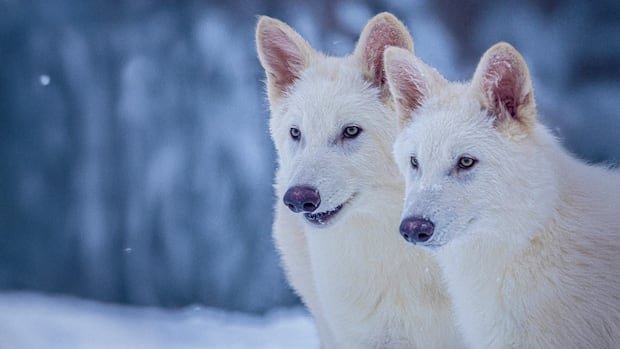It’s a fierce, majestic beast that disappeared thousands of years ago, save for artistic renderings in books and on screen, as in Game of Thrones.
Or, maybe, it’s just a grey wolf with a few tweaks.
American biotech company Colossal Biosciences made a surprise announcement Monday, claiming it had brought the dire wolf back from the dead, thus achieving the company’s first successful “de-extinction.”
Colossal showcased videos of the fluffy white wolf pups roaming in its 2,000-acre habitat at an undisclosed location in the northern U.S., marking a big win for the company that is also working on reviving the woolly mammoth, the dodo and the Tasmanian tiger.
But some scientists say that while the wolves’ existence is an impressive feat, they are not exactly as advertised.
“I want to see some peer-reviewed papers coming out of this, to get a better sense of what actually was done and what’s known and what’s not done,” said Hank Greely, director of Stanford University’s Center for Law and the Biosciences.

He says seeing the puppies put a smile on his face, and was a welcome surprise in an otherwise bleak news landscape.
But in his view, the creation is more of a “dire-ish wolf.”
“I do think that it is important for people to remember that these are not dire wolves. There are grey wolves that have some dire wolf characteristics,” Greely said. “On the other hand, they seem to be closer to dire wolves than anything else anybody’s seen for 13,000 years, and that’s pretty cool. And they’re cute as hell.”
Once hunted large prey
The large wolf species roamed the Americas for more than 100,000 years, before going extinct some 13,000 years ago.
It was believed to have hunted large prey like horses, bison and giant sloths, and to have disappeared largely because its prey species went extinct — partly because of hunting by humans.
Colossal’s chief scientific officer Beth Shapiro says scientists extracted DNA from a 13,000-year-old tooth and a 72,000-year-old inner ear bone from a dire wolf skull, and extracted and sequenced the DNA to assemble genomes.

They determined the grey wolf was its closest living relative — “99.5 per cent identical” in DNA, she says — and similar in appearance but bigger, more muscular and with a lighter coloured coat, wider skull and stronger jaw.
Scientists then altered grey wolf cells to give them dire wolf traits, making 20 edits in 14 genes before creating embryos and implanting them into large domestic hounds.
Three of the eight dogs used as surrogate mothers gave birth to dire wolves, Shapiro said, and the mothers were then adopted out anonymously through the American Humane Society — “so, somewhere out there, there are families that have adopted a dog that gave birth to a dire wolf, and they don’t know.”
Colossal says two male pups, Romulus and Remus, were born on Oct. 1 — putting them now in the early stages of adolescence — while Khaleesi, a female, was born on Jan. 30, and is almost at the age where she can be “introduced to the boys,” Shapiro said.
Kevin Campbell, a professor at the University of Manitoba’s Department of Biological Sciences, says while the pups look very much like dire wolves, it’s hard to know how similar they are physiologically.
“They edited 20 different mutations… which affected 14 genes. And to put this in perspective, a wolf probably has 22- or 23,000 different genes,” he said. “Right now what we have is a 99.999 per cent grey wolf, with .001 per cent dire wolf.”
Bringing back the phenotypes
Shapiro acknowledges the pups are not exactly the same as the dire wolves of yore, but says the idea was to create something with the same characteristic features that can live a healthy life in the modern age.
“When we’re thinking about de-extinction, we’re not imagining that we’re going to recreate something that’s genetically identical to something that used to be alive,” she told CBC News. “This is impractical and probably also not what we want. Instead, we want to bring back these phenotypes, the extinct traits that defined this species.”
Colossal CEO Ben Lamm says the project started about two years ago, as a way to get people talking about wolves and saving the critically endangered red wolf.
On that front, the private, Dallas-based company simultaneously announced Monday it had also produced four cloned red wolves using a new, less invasive technique it developed while working on the dire wolves.
Lamm says several Indigenous American communities have expressed interest in having dire wolves reintroduced on their land, but says that would be a complicated process requiring extensive consultation with landowners, governments and other stakeholders.
For now, Colossal is closely studying the dire pups and has no plans to introduce them to a wild habitat.
Some have criticized Colossal’s de-extinction projects for taking attention away from the less flashy work being done by organizations dedicated to conserving existing species and their habitats.
Joe Walston, head of global conservation at the Wildlife Conservation Society, says he appreciates that de-extinction projects can inspire people to think about species conservation, and he’s not opposed to using technology as one tool to help preserve species like the red wolf.
But most species, he says, can recover at an “incredible rate” if their habitats are simply conserved and left alone.
“We have tigers, we have lions, we have wolves themselves, we have these great predators ranging this earth which are in trouble and need our help,” he said.
“Sometimes we get too distracted by the newness of something and forget that what we have already on Earth at the moment is the most remarkable assemblage of species the world has ever seen.”

